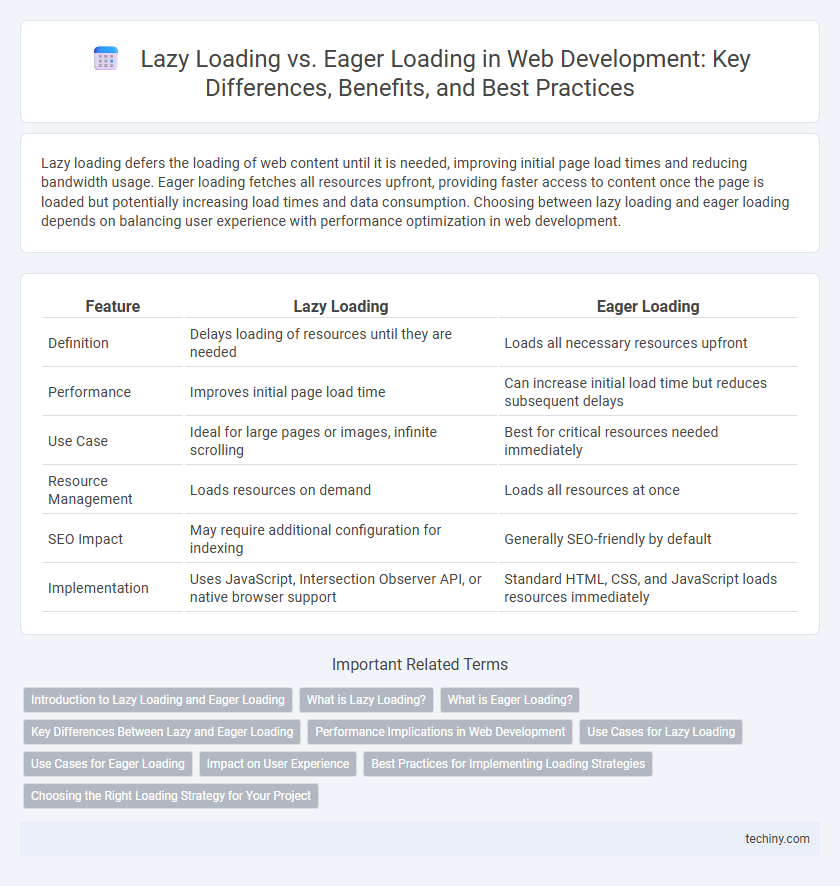Lazy loading defers the loading of web content until it is needed, improving initial page load times and reducing bandwidth usage. Eager loading fetches all resources upfront, providing faster access to content once the page is loaded but potentially increasing load times and data consumption. Choosing between lazy loading and eager loading depends on balancing user experience with performance optimization in web development.
Table of Comparison
| Feature | Lazy Loading | Eager Loading |
|---|---|---|
| Definition | Delays loading of resources until they are needed | Loads all necessary resources upfront |
| Performance | Improves initial page load time | Can increase initial load time but reduces subsequent delays |
| Use Case | Ideal for large pages or images, infinite scrolling | Best for critical resources needed immediately |
| Resource Management | Loads resources on demand | Loads all resources at once |
| SEO Impact | May require additional configuration for indexing | Generally SEO-friendly by default |
| Implementation | Uses JavaScript, Intersection Observer API, or native browser support | Standard HTML, CSS, and JavaScript loads resources immediately |
Introduction to Lazy Loading and Eager Loading
Lazy loading in web development defers the loading of non-critical resources until they are needed, improving initial page load speed and reducing bandwidth consumption. Conversely, eager loading loads all resources upfront, ensuring immediate availability but potentially increasing load times and resource usage. Choosing between lazy and eager loading depends on the application's performance requirements and user experience priorities.
What is Lazy Loading?
Lazy loading is a web development technique that defers the loading of non-essential resources, such as images and scripts, until they are needed or visible in the viewport. This method improves initial page load speed, reduces bandwidth consumption, and enhances user experience by prioritizing critical content. Implementing lazy loading is essential for optimizing performance on content-heavy websites and mobile applications.
What is Eager Loading?
Eager loading is a web development technique where related data or resources are loaded upfront during the initial page request, reducing the number of subsequent server calls and improving performance for datasets that will be used immediately. This approach contrasts with lazy loading by prefetching all necessary assets like images, scripts, or database relations to avoid delays during user interaction. Eager loading is effective in scenarios with predictable data usage, ensuring faster render times and smoother user experience by minimizing asynchronous loading interruptions.
Key Differences Between Lazy and Eager Loading
Lazy loading defers the initialization of objects or loading of resources until they are needed, improving initial load time and reducing memory usage in web development. Eager loading preloads all necessary objects or resources upfront, which can speed up access time but may increase initial load time and memory consumption. Choosing between lazy and eager loading depends on application requirements, balancing performance optimization with resource availability.
Performance Implications in Web Development
Lazy loading improves web performance by deferring the loading of non-critical resources until they are needed, reducing initial page load time and bandwidth consumption. Eager loading fetches all resources upfront, which can speed up interactions within the app but may increase initial load times and consume more memory. Choosing between lazy loading and eager loading depends on the application's complexity, user interaction patterns, and performance priorities.
Use Cases for Lazy Loading
Lazy loading improves web performance by deferring the loading of non-critical resources until they are needed, making it ideal for image galleries, videos, and long webpages with heavy content. It reduces initial page load time and bandwidth usage, enhancing user experience especially on mobile devices or slow networks. E-commerce sites and content-heavy platforms benefit significantly from lazy loading by loading product images and articles only when users scroll to them, optimizing resource allocation.
Use Cases for Eager Loading
Eager loading is essential in web development when immediate access to related data is required, such as displaying detailed user profiles with all associated posts and comments upfront. It improves performance in scenarios involving complex data relationships by reducing the number of database queries through pre-fetching related entities. Eager loading is particularly effective in applications where latency must be minimized to enhance the user experience during initial page loads.
Impact on User Experience
Lazy loading improves user experience by reducing initial page load time, allowing content to appear faster and conserving bandwidth by loading images or scripts only when needed. Eager loading fetches all resources upfront, potentially causing longer wait times and higher data usage but ensuring immediate access to all content without delays. Choosing between lazy and eager loading impacts perceived performance and responsiveness, directly affecting user satisfaction and engagement.
Best Practices for Implementing Loading Strategies
Implementing lazy loading in web development optimizes performance by deferring the loading of non-critical resources until they are needed, reducing initial page load time and enhancing user experience on mobile and low-bandwidth devices. Eager loading fetches all required resources upfront, improving responsiveness for applications where immediate data availability is crucial, such as interactive dashboards. Best practices recommend combining both strategies by lazy loading images and scripts below the fold, while eagerly loading essential assets, to balance performance and usability effectively.
Choosing the Right Loading Strategy for Your Project
Choosing between lazy loading and eager loading depends on your project's performance goals and user experience priorities. Lazy loading defers the loading of non-critical resources, improving initial page load times and reducing bandwidth usage, especially beneficial for large web applications with heavy multimedia content. Eager loading ensures all resources are loaded upfront, which can be advantageous for small, fast-loading pages where immediate access to all content is critical for user interaction.
Lazy Loading vs Eager Loading Infographic

 techiny.com
techiny.com